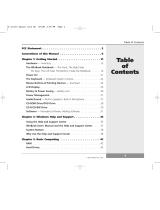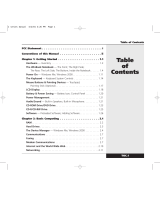User’s Manual
This Limited Warranty covers normal use. Preventive maintenance is not included. WinBook does
not warrant and will not be held responsible in any way for damages or loss resulting from a
cause other than defects in materials or workmanship, including damage or loss caused by;
neglect, accident, unreasonable use, software problems, peripheral equipment other than equip-
ment installed at the time of product purchase, or servicing or modification by anyone other than
WinBook or its designee; transit of equipment to WinBook for service, return or evaluation; any
natural disaster, including flood, fire, earthquake, or lightning; or electrical surges or use of
improper power sources.
WinBook’s liability under this limited warranty shall be limited solely to repair or replacement as
provided for above, and WinBook assumes no risk of, and shall not in any case be liable for, any
other damages, including, without limitation, any special, incidental, consequential or punitive
damages, arising from breach of warranty or contract, negligence or any other legal theory,
including without limitation, loss of goodwill, profits or revenue, loss of use of the Product or any
associated equipment, cost of capital, cost of any substitute equipment, facilities or services,
downtime costs, or claims of any party dealing with the Purchaser for such damages. The
employees and agents of WinBook are not authorized to make modifications to warranties, or
additional warranties binding on WinBook; accordingly, additional statements, whether oral or
written, do not constitute warranties and should not be relied upon by the Purchaser.
The warranties set forth in this warranty statement allocate the risks of Product failure between
seller and buyer as authorized by the Uniform Commercial Code and other applicable law.
WinBook’s Product pricing reflects the allocation risk and the limitations of liability contained in
this statement.
This one-year limited warranty is exclusive. Some states do not allow limitations o how long an
implied warranty lasts or do not allow the exclusion or limitation of incidental or consequential
damages, so any such limitation or exclusion may not apply to you. This Warranty gives you spe-
cific legal rights. You also have other rights which may vary from state to state.
To obtain service under this Agreement:
Merchandise must be received within one year of purchase and be accompanied by proof of pur-
chase. If you ship the unit to WinBook for service, WinBook will not be responsible for shipping
charges, loss or damage in transit, shipping charges, loss or damage in transit, shipping contain-
ers or packing supplies. You are responsible for all shipping materials should the original packag-
ing materials not be available. The customer must call WinBook Technical Support and obtain an
RMA number before the unit can be sent to WinBook.
6
N4 manual w/no OS 3/7 3/11/02 3:38 PM Page 6






























